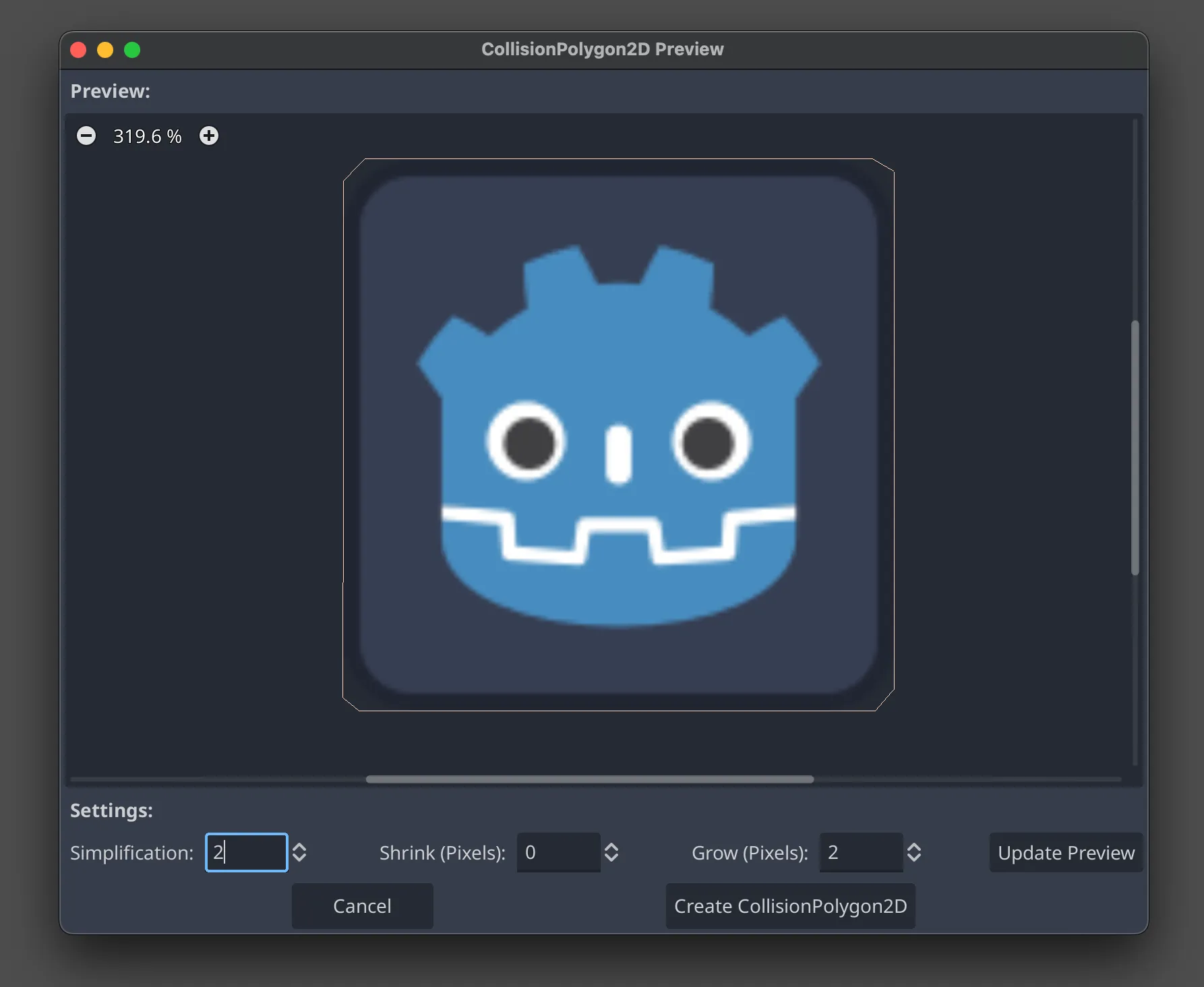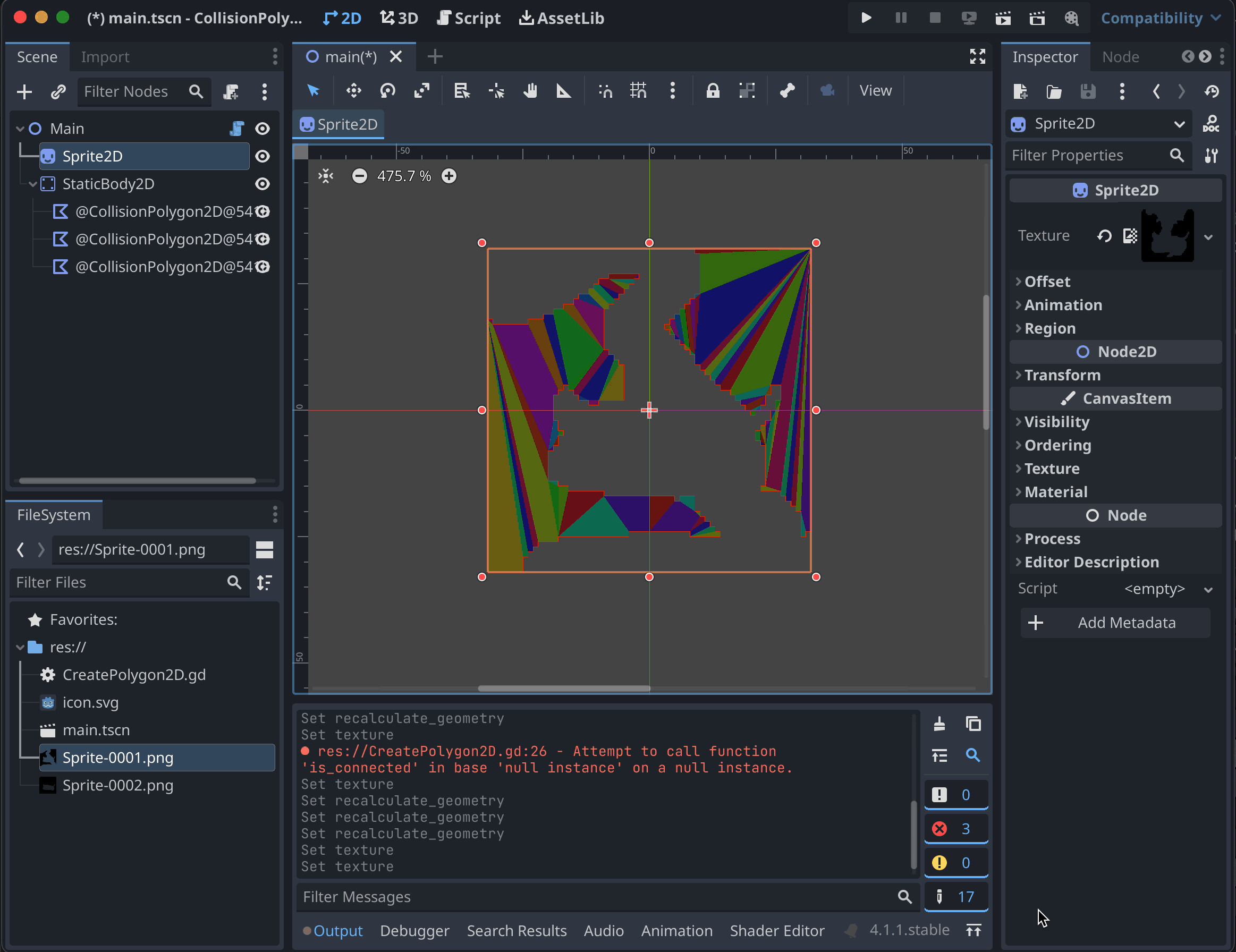Generate Pixel Perfect Colliders from Sprites in Godot
How I created a tool script that automatically generates pixel perfect colliders from a 2D sprites as the image changes.
Recently I was watching Adam from Indie Tales on Twitch working on a game jam entry in Godot. He was quickly iterating on level layouts and wanted to find a way to generate colliders from the level sprites he was drawing without needing to manually delete and recreate collision siblings every time he changed his artwork.
Although I don’t yet have a great deal of experince in Godot, this seemed like an interesting problem to solve so I dug in.
Existing Functionality
To start I’ll point out that there is a built-in tool to create collision shapes from sprites in Godot. To access it, you click the Sprite2D dropdown when you have a Sprite2D node selected.

Clicking on that option brings up a modal that will allow you to customize and then create your CollisionPolygon2D node.

If you’re not changing your art often, this feature will probably be all you ever need. In Adam’s case, he was making constant changes to level artwork, moving back and forth between Aseprite and Godot to adjust the level and then playtest it. Needing to delete the existing CollisionPolygon2D node and then step through the creation process after each change was tedious.
Creating a Tool Script
In Godot, you can run code inside the editor by adding @tool at the top of a script. In this case, I figured there would likely be a way to tap into the functionality the modal was providing by writing a script that performs the same actions.
To ensure we’re only running the code in the editor, we also need to call the Engine.is_editor_hint() function. If this function returns true, we’re currently working in the editor. Here’s the initial setup of the script:
@tool
extends Node2D
# Regenerate Collision Nodes When Texture Changes
func _ready():
if Engine.is_editor_hint():
# TODO: Initialize tool logic hereIn researching how to implement this functionality, I found that a Sprite2D node fires a signal when it’s attached texture changes. In my _ready function, I connected that signal to another function that would do the heavy lifting:
func _ready():
if Engine.is_editor_hint():
$Sprite2D.connect("texture_changed", _create_polygon2d_nodes_from_sprite2d)
func _create_polygon2d_nodes_from_sprite2d():
passNow every time we assign a new image to our sprite, or the sprite artwork changes, a signal will fire to execute the code in _create_polygon2d_nodes_from_sprite2d. From here we can start implementing an algorithm for creating our collision polygon.
First we need to add a reference to the nodes we’ll need to work with. Because I knew the context this script would be used in, I could assume that certain nodes existed as children of the Node2D that I was attaching my script to.
func _create_polygon2d_nodes_from_sprite2d():
# Assume Sprite2D with texture and StaticBody2D exist
var sprite = $Sprite2D
var static_body = $StaticBody2DNext I needed to remove any existing collision polygons so that we weren’t creating additional colliders. To do that, we look for all child nodes of our StaticBody2D node and destroy them by calling queue_free.
# Destroy Existing Collision Polygons
for node in static_body.find_children("*", "CollisionPolygon2D"):
node.queue_free()Generating the new collision polygon is where things got a little trickier. I ultimately needed to work backwards from the CollisionPolygon2D node. That node can assign a polygon which is a PackedVector2Array[]. I didn’t see any way to go straight from a Sprite2D to a PackedVector2Array[], but I did discover a method on Bitmap that converts opaque pixels to polygons, and those polygons are represented as a PackedVector2Array[].
The opaque_to_polygons method takes two arguments; a Rect2i and then a value for epsilon which controls the precision of the polygons being generated. A higher number is more performant, while a lower number is more precise. In my case I used an epsilon value of 0.0 to ensure the polygons were pixel perfect.
I was getting close, but now I needed to find a way to convert a Sprite2D to a Bitmap. The connection between the two ended up being the Image class. A Sprite2D texture has a get_image method, and Bitmap has a create_from_image_alpha.
Putting all of that together we first get the image from the sprite. Then we initialize a new Bitmap and assign it’s data the image. After that we get all of the unique polygons in the bitmap (this accounts for disconnected areas of pixels in the original image), and then we use those polygons to create colliders.
# Generate Bitmap from Sprite2D
var image = sprite.texture.get_image()
var bitmap = BitMap.new()
bitmap.create_from_image_alpha(image)
# Convert Bitmap to Polygons
var polys = bitmap.opaque_to_polygons(Rect2(Vector2.ZERO, image.get_size()), 0.0)
# Create CollisionPolygon2D Node for each Polygon
for poly in polys:
var collision_polygon = CollisionPolygon2D.new()
collision_polygon.polygon = poly
static_body.add_child(collision_polygon)
collision_polygon.set_owner(get_tree().get_edited_scene_root())
collision_polygon.position -= sprite.texture.get_size() / 2The Final Result
Putting everything together, we can now change on our sprite and our colliders are automatically updated.

Here’s the full script for Godot 4:
@tool
extends Node2D
# Regenerate Collision Nodes When Texture Changes
func _ready():
if Engine.is_editor_hint():
$Sprite2D.connect("texture_changed", _create_polygon2d_nodes_from_sprite2d)
func _create_polygon2d_nodes_from_sprite2d():
# Assume Sprite2D with texture and StaticBody2D exist
var sprite = $Sprite2D
var static_body = $StaticBody2D
# Destroy Existing Collision Polygons
for node in static_body.find_children("*", "CollisionPolygon2D"):
node.queue_free()
# Generate Bitmap from Sprite2D
var image = sprite.texture.get_image()
var bitmap = BitMap.new()
bitmap.create_from_image_alpha(image)
# Convert Bitmap to Polygons
var polys = bitmap.opaque_to_polygons(Rect2(Vector2.ZERO, image.get_size()), 0.0)
# Create CollisionPolygon2D Node for each Polygon
for poly in polys:
var collision_polygon = CollisionPolygon2D.new()
collision_polygon.polygon = poly
static_body.add_child(collision_polygon)
collision_polygon.set_owner(get_tree().get_edited_scene_root())
collision_polygon.position -= sprite.texture.get_size() / 2
This example requires a specific node hierarchy to exist, but the script could be tweaked to be a little more flexible if this is something you find yourself needing. I have the example project files for Godot 3.5 and 4.x available on Github.